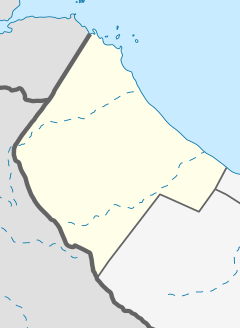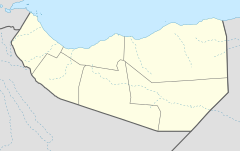Masjid al-Qiblatayn, Zeila
| Masjid al-Qiblatayn ( Arabic: مَـسْـجِـد الْـقِـبْـلَـتَـيْـن) "Masjidka Labada Qibla" "Mosque of the two Qiblahs" | |
|---|---|
 | |
| Religion | |
| Affiliation | Islam |
| Region | Horn of Africa |
| Location | |
| Location | Zeila, Awdal, Somaliland. |
| Geographic coordinates | 11°21′14″N 43°28′26″E / 11.35389°N 43.47389°E |
| Architecture | |
| Type | mosque |
| Minaret(s) | 1 |
Masjid al-Qiblatayn (
Date
The oldest remains on site are undated[3] and further archeological investigation is needed to understand them.[4] According to local oral tradition, the family of Muhammad migrated to Abyssinia around the mid-7th century and constructed the mosque then.[5][4][6][7]
At present, scholarly dates for the Islamicization of the region are uncertain and may be as late as the thirteenth and fourteenth centuries, though others suggest a possibly earlier but unknown date.[8][9]
Description
The mosque's name means 'mosque of the two qiblahs', referring to its two mihrabs. According to tradition, one of the mihrabs was oriented north toward Mecca and the other northwest toward Jerusalem.[4][10]
The building is largely in ruins. This is due to repeated diggings as well as exposure of the foundations of the structure, without any conservation efforts protecting the site. In 2007, George Abungu produced a report of the site as part of a UNESCO assessment mission.[10]
Only one mihrab, oriented northward, was visible. The remains of another structure nearby are visible, possibly indicating that the mosque underwent two different phases of construction. It also contains the tomb of a sheikh named Babu Dena.[4]
See also
- Lists of mosques
- List of mosques in Africa
- List of mosques in Egypt
- Arba'a Rukun Mosque
- Fakr ad-Din Mosque
- Islam in Africa
- Mosque of Islamic Solidarity
- Dir (clan)
References
- ISBN 978-3-11-067801-7.
- ISBN 978-0-7556-3515-3.
- ISBN 978-0-19-998788-7.
- ^ ISBN 9782821882652.
- ISSN 1572-9842.
- ISBN 978-1841623719.
- ^ The Muslim World. Motamar al-Alam al-Islami; World Muslim Congress. 1964. p. 7.
- OCLC 959035754.
- ISBN 978-0-231-70023-8.
- ^ ISBN 978-0-19-750787-2.


